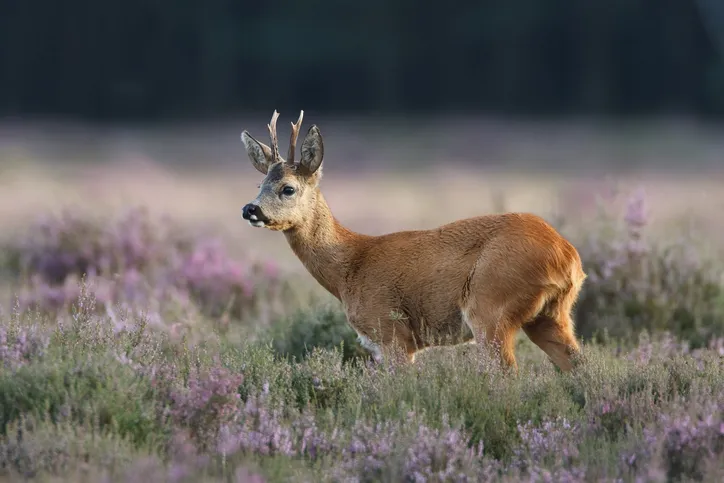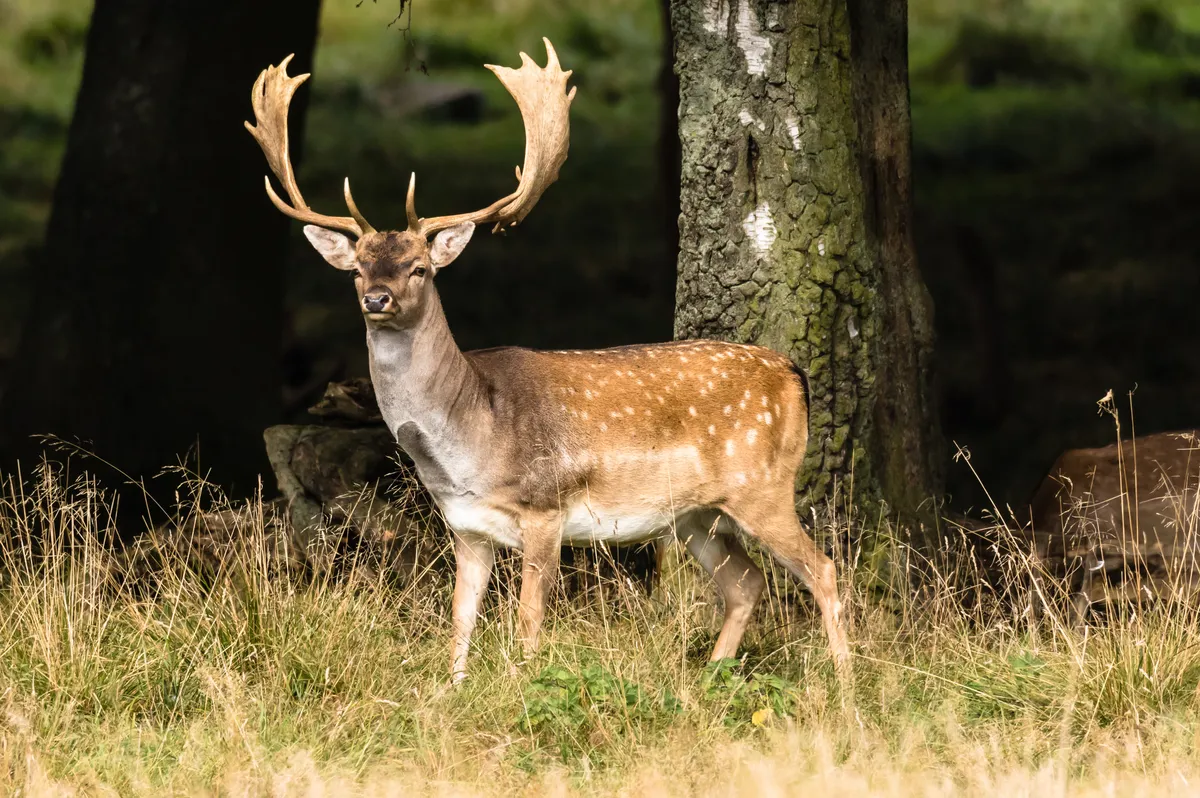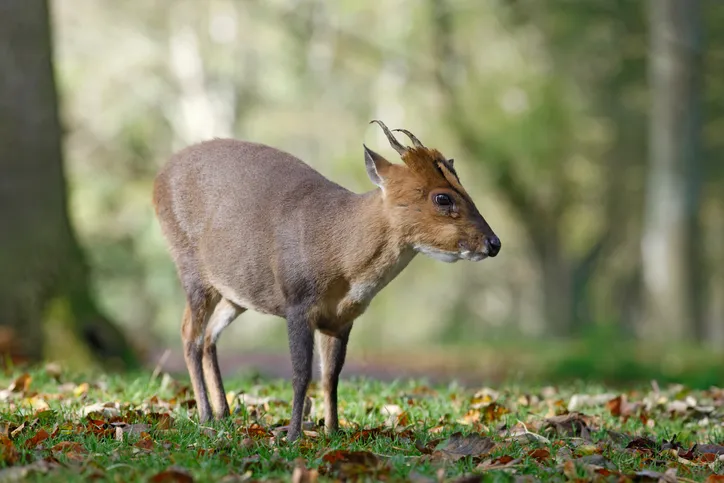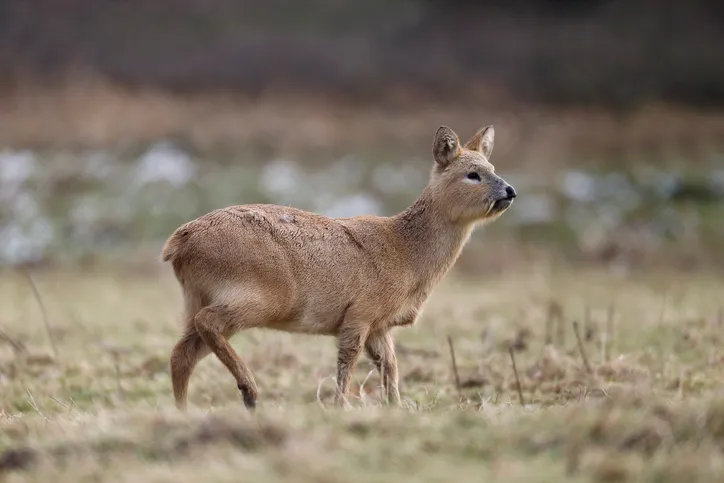Britain’s deer populations are expanding, yet most of us see them rarely as they are secretive woodland dwellers. During the autumn deer rut, they are much more noticeable due to their need to mate and they can be very vocal.
Of the six species of deer found in the British countryside, however only roe and red deer are indigenous to Britain. Fallow deer are thought to have been introduced during the Norman period, while muntjac, Chinese water deer and silka deer were introduced in the 19th and 20th centuries.
Catching a fleeting glimpse of a deer on the landscape is an exciting wildlife spectacle. Many of the UK's Royal parklands are home to deer, including Richmond Park and Bushy Park in London.
Here’s our guide to the six deer species found in the British countryside, including best places to see and how to identify.
What do deer eat?
Deer eat grass, leaves, fruits, berries and woody plants, they can cause some damage to trees when they eat the bark or shoots of trees.
What is a young deer called?
A young deer is called a fawn, a female deer is called a doe or hind, and a male deer is known as a stag or buck.
What do you call a group of deer?
A group of deer is called a herd.

What species of deer are found in the UK?
In Britain there are six species of deer to be found in the wild, including red deer, roe deer, fallow deer, muntjac, Chinese water deer and sika deer.
Red deer
Red deer migrated to Britain from Europe 11,000 years ago, making them one of two of the country's truly indigenous species. Since their arrival, populations have risen and fallen with the loss and creation of suitable habitat. One of the UK's most adaptable mammals, red deer are currently expanding in both range and numbers – while preferring woodland and forest habitats in England and southern Scotland, their opportunism has led to their inhabitation of open moor and hills too.

Red deer facts
- Habitat: Prefer forests and woodlands, but have adapted to live on open moor.
- Distribution: Scottish Highlands, Southern Scotland, Lake District, East Anglia, Northern England, Midlands, East Anglia, the New Forest, Sussex and south-west England.
- Behaviour: In forests, red deer are mostly solitary or exist in small groups, largely active at dawn and dusk. In open moorland, namely the Scottish Highlands, populations group in larger numbers in the day, dropping into the valleys at night.
- Fun fact: Red deer are Britain’s largest land mammal.
What do red deer eat?
Grass, young shrubs (like heather), tree shoots and crops.
When is the red deer breeding season?
End of September to November is the main breeding season for red deer?
How big are red deer?
Red deer shoulder height is up to 137cm in males and females are up to 122cm. Weight wise red deer are up to 190kg in males and females are up to 120kg.
How long do red deer live in the wild?
Red deer have a lifespan of up to 18 years.
Roe deer
This native British deer is rusty brown in the summer months, turning grey, pale brown or sometimes black in winter. The small antlers with three prongs on males are known as tines. Roe deer are easily startled – their rumps bounding through forests and crops are a familiar sight to walkers and cyclists. They became extinct in England in the 1800s due to forest clearance and over-hunting, though the species remained in parts of Scotland. These days, they are widespread and abundant.

Roe deer facts
- Habitat: Prefer woodland and forest but also spend time in open fields.
- Distribution: Throughout the British Isles, thinning out in parts of the Midlands and Kent.
- Behaviour: Generally solitary animals, but group together in winter. Active 24 ours a day, though more inclined to venture into open space at night. Males rut in breeding season, while courtship between the buck and doe involves chasing. When alarmed, a roe deer makes a dog-like barking call.
What do roe deer eat?
Herbs, brambles, ivy, heather, bilberry and young tree shoots.
When is the roe deer breeding season?
Mid-July to mid-August.
How big are roe deer?
Roe deer reach up to 75cm at shoulder height and weigh up to 25kg.
How long do roe deer live for in the wild?
Roe deer have a lifespan of up to 10 years.
Fallow deer
This medium-sized deer has palmate antlers. Coats vary in colour, from black and caramel to the more common tawny and white-spotted coat. Does and young have short barks, while bucks emit a deep groan, especially in mating season. Not a truly native species, as they are thought to have been introduced by the Normans in the 10th century. They are the only British deer with palmate antlers (meaning a similar shape to hands or feet).

Fallow deer facts
- Habitat: Deciduous woodland and thick, low-lying vegetation.
- Distribution: Found throughout Britain, particularly in England, with numbers rising.
- Behaviour: Live in both single-sex and mixed groups.
What do fallow deer eat?
Fallow deer prefer grasses but will graze young shrubs.
When is the fallow deer breeding season?
Late September to October.
How big are fallow deer?
Stags are slightly larger than hinds, reaching up to 94cm at the shoulder (females up to 91cm). Stags weight up to 94kg with the much slighter females reaching only 56kg.
How long do fallow deer live for in the wild?
Fallow deer have a lifespan of up to 16 years.
Reeves' muntjac deer
This small, hunched deer was brought over from China in the early 20th century, spreading from Bedfordshire to populate large swathes of England. Unlike other deer species, muntjac have little impact on agricultural and timber crops. They breed all year round and are able to have kids when they are seven months old. Muntjac deer have both antlers and tusks (enlarged upper canines).

Muntjac deer facts
- Habitat: Prefer woodlands but have adapted to live in urban areas and overgrown gardens.
- Distribution: Abundant in England, particularly the east, increasing in both number and range.
- Behaviour: Solitary or found in pairs, mostly active and dawn and dusk.
What do muntjac eat?
Muntjac eat a wide variety of grasses, herbs and shrubs.
When is the muntjac breeding season?
Muntjac do not have a specific deer rut – they can breed all year round, leading to rapid population growth.
How big are muntjac?
Muntjac reach just 52cm tall at the shoulder and weigh up to 18kg.
How long do muntjac live for in the wild?
Muntjac deer are relatively long lived – reaching up to 19 years.
Sika deer
Also known as Japanese deer, this medium-sized species arrived on Brownsea Island in Dorset in 1860. Escapees quickly spread through Britain, forming strongholds in much of Scotland. Like fallow deer, their coats vary from pale to dark, and they often have white rumps. As with red deer, female sikas are know as 'hinds' and males known as stags.

Sika deer facts
- Habitat: Acid soils such as conifer woodlands, moorland and heath.
- Distribution: Increasing across the UK, with large populations in Scotland and Northern Ireland.
- Behaviour: Live in single-sex groups.
What do sika deer eat?
Sika deer each grasses and shrubs, sometimes eating tree bark and young tree shoots.
When do sika deer breed?
The sika deer rut runs from September to November. Hinds give birth between May and July.
How big are sika deer?
Sika deer stags reach up to 95cm at the shoulder with hinds up to 90cm. Weight: Up to 70kg (females up to 45kg).
How long do sika deer live for in the wild?
Sika deer are quite short-lived, averaging about 12 years.
Chinese water deer
A small russet-coloured deer, turning light grey in winter. Found in wet areas, as their name suggests, these non-native deer are without antlers (though the males do have tusks). Introduced into the British countryside in the 1890s, they have spread through south-east England. Although not native to the UK, Chinese water deer numbers in Britain now account for 10% of the global population.

Chinese water deer facts
- Habitat: Lakes, riverbanks and reedbeds.
- Distribution: Mostly eastern England.
- Behaviour: Generally solitary, coming together during mating season. Active all day, though mostly at dawn and dusk.
What do Chinese water deer eat?
Chinese deer will eat most vegetation: grasses, herbs and woody material.
When do Chinese water deer breed?
Chinese water deer breed from late autumn into early winter, giving birth in June and July.
How big are Chinese water deer?
Chinese water deer are relatively small, reaching up to 55cm at the shoulder and weighing up to 18kg.
How long do Chinese water deer live for?
Chinese water deer can live for up to 13 years.
The British Deer Society (BDS)
BDS promotes deer education, research and management best practice to ensure a healthy and sustainable deer population in balance with the environment; a key feature of the biodiversity of the UK landscape. bds.org.uk
Where do deer sleep?
Deer don't hibernate so in the winter months, so the herd tends to sleep in the warmest place they can find.
What noise does a deer make?
Bucks make loud grunting noises – particularly during the rutting season.
What is the deer rut?
The deer rutting season is the time that male deers, known as stags or bucks, fight over females by fighting with each other or rubbing their antlers on trees. They will also herd the female deer, known as a doe or a hind together. In the UK the deer rut takes place between October and November.
What are deer antlers made of?
Deer antlers are made a bone type of material that regenerates annually. The antler is fed by blood and protein and is covered by an outer velvet covering.


